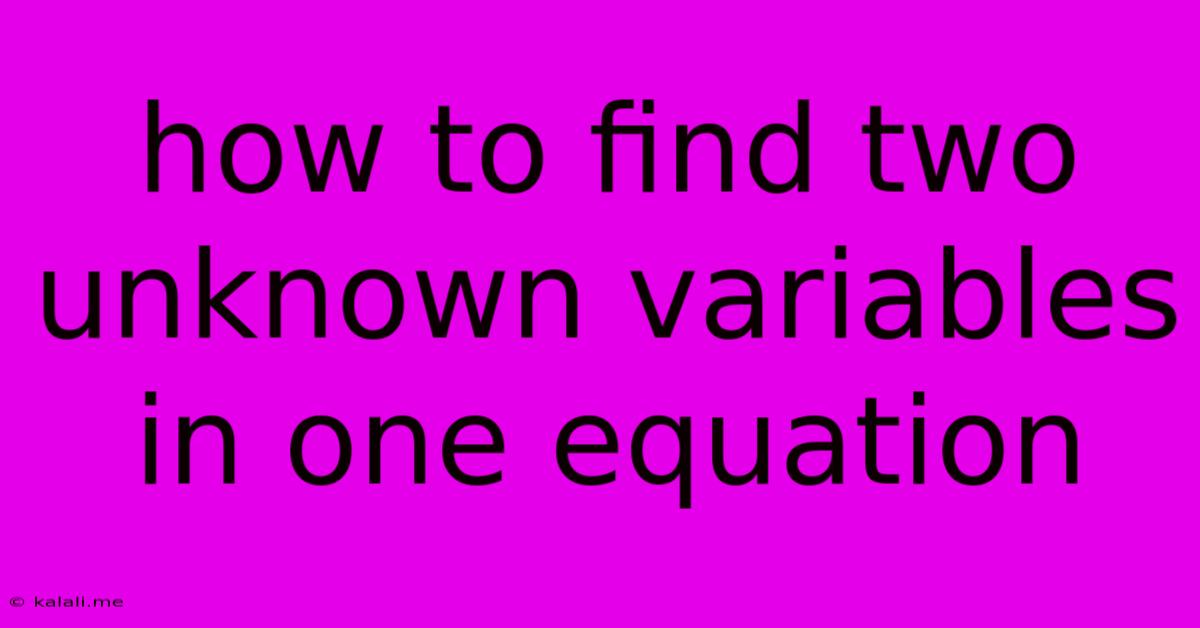How To Find Two Unknown Variables In One Equation
Kalali
Jun 02, 2025 · 3 min read

Table of Contents
How to Find Two Unknown Variables in One Equation: A Guide to Understanding the Limitations and Exploring Solutions
Finding two unknown variables with only one equation is a common problem in algebra, but it's crucial to understand that it's generally impossible to find unique solutions in this scenario. This article will explore why this is the case, and outline the approaches you can take depending on the type of equation you're dealing with. The key takeaway is that you'll need additional information or constraints to obtain definitive answers.
Why One Equation Isn't Enough
Imagine you have a single equation like: x + y = 10. This equation represents an infinite number of possible solutions. For example:
x = 5, y = 5x = 1, y = 9x = 0, y = 10x = -1, y = 11
And so on. Each pair of x and y values satisfies the equation. Without another equation providing a different relationship between x and y, you can't pinpoint a unique solution. This is a fundamental concept in solving systems of equations. To find unique solutions for multiple unknowns, you need as many independent equations as you have unknowns (this is known as a well-posed problem).
Approaches and Considerations
While you can't find definitive values for two unknowns with a single equation, certain approaches can be helpful depending on the context:
1. Expressing One Variable in Terms of the Other
You can rearrange the equation to solve for one variable in terms of the other. Using the example x + y = 10, we can rearrange it as:
x = 10 - yory = 10 - x
This is useful if you have additional information about the relationship between x and y. For instance, if you're told that x is twice the value of y, you could substitute x = 2y into the original equation and solve for a specific solution.
2. Graphing the Equation
Plotting the equation on a Cartesian coordinate system shows all possible solutions visually. The graph of x + y = 10 is a straight line. Every point on that line represents a valid solution pair (x,y). This visual representation is helpful in understanding the infinite possibilities.
3. Introducing Additional Constraints or Information
The most effective solution is often to look for additional information. This might come in the form of a second equation, a constraint on the range of values for x and y (e.g., x and y must be positive integers), or additional contextual information related to the problem. With a second independent equation, you can use techniques such as substitution, elimination or matrices to solve for unique values of x and y.
4. Special Cases: Non-Linear Equations
For non-linear equations (those that don't graph as a straight line), the situation can become even more complex. Sometimes, you might find a limited number of solutions, but obtaining a full understanding often requires advanced mathematical techniques.
In Conclusion
Finding two unknown variables with only one equation is typically unsolvable in the sense of finding unique values. You need at least as many independent equations as you have unknowns. However, manipulating the single equation, visualizing its solution set, or incorporating additional constraints can provide valuable insights and potentially allow you to determine specific solutions under certain conditions. Remember that the key is to look for more information to make the problem solvable.
Latest Posts
Latest Posts
-
Turn Order For A 4 Way Stop
Jun 04, 2025
-
Why Do Dogs Lick Other Dogs Mouths
Jun 04, 2025
-
How To Replace A Water Heater Element
Jun 04, 2025
-
How To Hide Folders From Player Foundry
Jun 04, 2025
-
Channel 3 Open Failed Connect Failed Connection Refused
Jun 04, 2025
Related Post
Thank you for visiting our website which covers about How To Find Two Unknown Variables In One Equation . We hope the information provided has been useful to you. Feel free to contact us if you have any questions or need further assistance. See you next time and don't miss to bookmark.